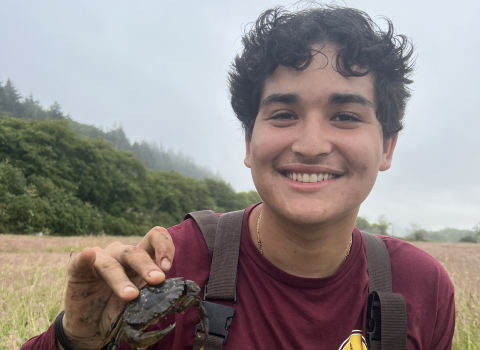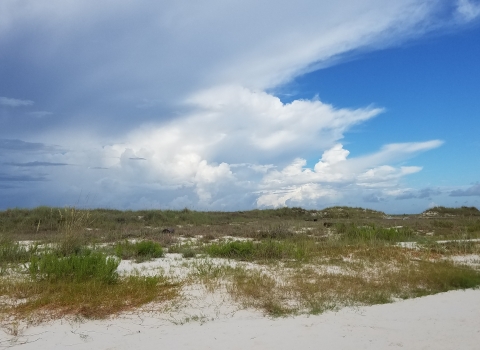The lands and waters of the National Wildlife Refuge System offer a haven for species that are facing extinction. After more than 50 years of supporting the Endangered Species Act, we at the U.S. Fish and Wildlife Service are shining a light on some of the special places that help protect threatened and endangered species.
Kirtland’s Warbler Wildlife Management Area was established on September 3, 1980, in response to the need for more land dedicated to the recovery of the endangered Kirtland’s warbler, which was listed under the Endangered Species Act from 1967 to 2019. The management area is made up of 125 tracts of land totaling more than 6,000 acres in eight counties in the northern Lower Peninsula of Michigan.
Even though the Kirtland's warbler was delisted due to recovery in 2019, our work isn't done. Today, we aim to connect areas of habitat for Kirtland’s warblers and other focal species in and around Michigan’s jack pine forest and pine barren ecosystems. These islands of habitat are made stronger when we connect them. We manage this habitat to simulate the structure and composition of a recently burned jack pine forest. Kirtland’s warblers build nests on the ground, only in young, dense stands of jack pine in Michigan, Wisconsin and Ontario. This habitat was historically created by large wildfires. Today, wildfires are suppressed, and the nesting habitat is created by harvesting mature jack pine and planting jack pine seedlings in the logged areas.
Young jack pine stands are crucial habitat for the warbler and many other species. Because Kirtland’s warblers prefer a very specific age group of jack pine trees, the forests are divided into three categories. Sort of like Goldilocks, the warbler is very picky about where it lives. Too young or too old and the warbler will not use the forest. The young jack pine forests which are between four and 15 years old are just right.
Each forest age is associated with a different wildlife community. Young jack pine forests are not only essential habitat for the Kirtland’s warbler, but they are home to other birds like the Nashville warbler, eastern towhee, brown thrasher and alder flycatcher. Very young jack pine forests that are four years or younger provide habitat for indigo buntings, eastern bluebirds, field and Lincoln’s sparrows and black-billed cuckoo. Jack pine forests that are 15 years and older provide habitat for black-backed woodpeckers, spruce grouse, olive-sided flycatchers, eastern wood-pewees, hermit thrushes, ovenbirds, rose-breasted grosbeaks, red-breasted nuthatches, red-eyed vireos, black-capped chickadees, chipping sparrows and mourning doves.
Endangered species recovery is complex work, often requiring substantial time and resources. Species today face ongoing threats like habitat loss as well as climate change climate change
Climate change includes both global warming driven by human-induced emissions of greenhouse gases and the resulting large-scale shifts in weather patterns. Though there have been previous periods of climatic change, since the mid-20th century humans have had an unprecedented impact on Earth's climate system and caused change on a global scale.
Learn more about climate change and wildlife trafficking. We have a continued commitment as a nation to protect imperiled species. Each of these species is a part of the web of life, each with a unique cultural and biological community, performing services that are essential to our combined well-being. By conserving them, we help ensure the benefits that accrue from them - healthy air, land and water - on which we depend.
Every four years, biologists survey the population as a measure of species health. At the lowest points, populations had dipped to 167 pairs in 1974 and 1987. As of the last survey in 2021, the Kirtland’s warbler global population is estimated at 2,245 pairs - more than double the recovery goal. Goals have been exceeded every year since the early aughts!
Work isn’t over for the Kirtland’s warbler, even though it was delisted due to recovery. Referred to as conservation-reliant, species like Kirtland’s warblers require active management from biologists and land managers even after Endangered Species Act protections are removed. That’s partly because their habitat was traditionally regenerated by wildfire, which has largely been removed from the equation. That said, we’ll continue to adjust specialty habitats as conditions warrant. In doing so, we’ll collaborate with the U.S. Forest Service, Michigan Department of Natural Resources and other partners to ensure enough suitable nesting habitat is available for the Kirtland’s warbler.
Know before you go
If you’re hoping to get a good glimpse of the Kirtland’s warbler at its namesake wildlife management area wildlife management area
For practical purposes, a wildlife management area is synonymous with a national wildlife refuge or a game preserve. There are nine wildlife management areas and one game preserve in the National Wildlife Refuge System.
Learn more about wildlife management area , you’re in luck! When the weather is nice, you have a good chance of seeing the Kirtland’s warbler, as well as many other neotropical migrant bird species. You’re welcome to look for wildlife, take photos, enjoy interpretive tours and learn more through educational field trips. Please be aware that during hunting season, hunters visit in search of game birds, upland game and big game species.
While Kirtland’s Warbler Wildlife Management Area does not have any official trails, these lands may have old roads which run throughout the properties. Many of these old roads are the perfect place to take a walk. We encourage you to get out and explore while staying on these established roads. Be aware that some habitat areas may be closed to recreation during the Kirtland’s warbler breeding season in spring and early summer.
Learn more about Kirtland’s Warbler Wildlife Management Area






